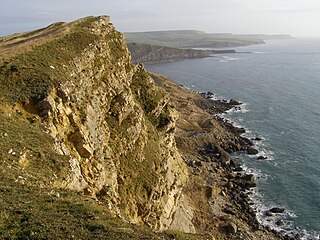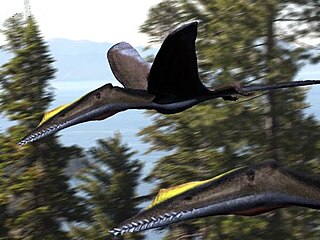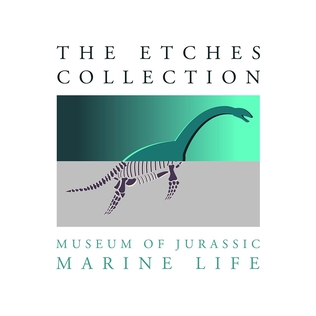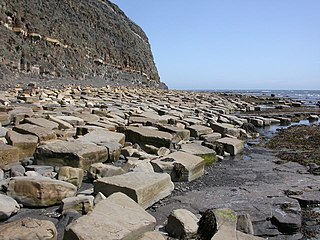
Kimmeridge is a small village and civil parish on the Isle of Purbeck, a peninsula on the English Channel coast in Dorset, England. It is situated about 4.5 miles (7.2 km) south of Wareham and 7 miles (11 km) west of Swanage. In 2013 the estimated population of the civil parish was 90.
Gigantosaurus is a dubious genus of sauropod dinosaur from the Late Jurassic Kimmeridge Clay Formation of England. The type species, Gigantosaurus megalonyx, was named and described by Harry Govier Seeley in 1869. Its syntype series consists of several separately discovered sauropod bones found in Cambridgeshire, including two caudal (tail) vertebrae, the distal end of a tibia, a cast of the right radius, a cast of phalanx and an osteoderm. It was synonymised to Ornithopsis humerocristatus by Richard Lydekker in 1888 and to Pelorosaurus by Friedrich von Huene in 1909. Today it is considered a nomen dubium.

Cumnoria is a genus of herbivorous iguanodontian dinosaur. It was a basal iguanodontian that lived during the Late Jurassic period in what is now Oxfordshire, United Kingdom.

The Kimmeridge Clay is a sedimentary deposit of fossiliferous marine clay which is of Late Jurassic to lowermost Cretaceous age and occurs in southern and eastern England and in the North Sea. This rock formation is the major source rock for North Sea oil. The fossil fauna of the Kimmeridge Clay includes turtles, crocodiles, sauropods, plesiosaurs, pliosaurs and ichthyosaurs, as well as a number of invertebrate species.

Pliosaurus is an extinct genus of thalassophonean pliosaurid known from the Kimmeridgian and Tithonian stages of Europe and South America. Most European species of Pliosaurus measured around 8 metres (26 ft) long and weighed about 5 metric tons, but P. rossicus and P. funkei would have been one of the largest plesiosaurs of all time, exceeding 10 metres (33 ft) in length. This genus has contained many species in the past but recent reviews found only six to be valid, while the validity of two additional species awaits a petition to the International Code of Zoological Nomenclature. Currently, P. brachyspondylus and P. macromerus are considered dubious, while P. portentificus is considered undiagnostic. Species of this genus are differentiated from other pliosaurids based on seven autapomorphies, including teeth that are triangular in cross section. Their diet would have included fish, cephalopods, and marine reptiles

Aulacostephanus is an extinct ammonoid cephalopod genus from the Upper Jurassic Tithonian belonging to the perisphinctoidean family Aulacostephanidae.

Kimmerosaurus is an extinct genus of plesiosaur from the family Cryptoclididae. Kimmerosaurus is most closely related to Tatenectes.

Colymbosaurus is a genus of cryptoclidid plesiosaur from the Late Jurassic (Callovian-Tithonian) of the UK and Svalbard, Norway. There are two currently recognized species, C. megadeirus and C. svalbardensis.

Nannopterygius is an extinct genus of ophthalmosaurid ichthyosaur that lived during the Middle Jurassic to the Early Cretaceous. Fossils are known from England, Kazakhstan, Russia, and Norway and six species are currently assigned to the genus.

Bathyspondylus is an extinct genus of plesiosaur from the Kimmeridge Clay Formation of Swindon, England. Because it is known only from its fossil vertebrae, paleontologists are not entirely sure of the taxonomy of Bathyspondylus; the family it belongs to is not currently known. The type, and only known, species is B. swindoniensis, which was described from the same material as its genus.

Kimmeridge Bay is a bay on the Isle of Purbeck, a peninsula on the English Channel coast in Dorset, England, close to and southeast of the village of Kimmeridge, on the Smedmore Estate. The area is renowned for its fossils, with The Etches Collection in the village of Kimmeridge displaying fossils found by Steve Etches in the area over a 30-year period. It is a popular place to access the coast for tourists. To the east are the Kimmeridge Ledges, where fossils can be found in the flat clay beds.

Gad Cliff is a south-facing cliff face, immediately to the east of Worbarrow Tout and Pondfield Cove, on the south coast of the Isle of Purbeck in Dorset, England. Behind it is Gold Down, part of the Lulworth Ranges.

Brandy Bay is a small secluded southwest-facing bay, with an oil shale and shingle beach immediately below Gad Cliff and Tyneham Cap, to the east of Worbarrow Bay and to the west of Hobarrow Bay on the south coast of the Isle of Purbeck, in Dorset, England.

Cuspicephalus is an extinct genus of monofenestratan pterosaur known from Dorset in England. Its fossil remains date back to the Late Jurassic period.
Spitrasaurus is an extinct genus of cryptoclidid plesiosauroid plesiosaur known from the uppermost Jurassic of central Spitsbergen, Norway and likely also Kimmeridge, England. It is named after a syllabic abbreviation for Spitsbergen Travel.

Cephalopod egg fossils are the fossilized remains of eggs laid by cephalopods. The fossil record of cephalopod eggs is scant since their soft, gelatinous eggs decompose quickly and have little chance to fossilize. Eggs laid by ammonoids are the best known and only a few putative examples of these have been discovered. The best preserved of these were discovered in the Jurassic Kimmeridge Clay of England. Currently no belemnoid egg fossils have ever been discovered although this may be because scientists have not properly searched for them rather than an actual absence from the fossil record.

Steve Etches, MBE is an English plumber, fossil collector and preparator in Kimmeridge, on the Isle of Purbeck. From an early age on, Etches began to find, collect and restore the fossils he found on the Jurassic Coast. His collection is now housed in a museum called The Etches Collection which was purpose-built, both to house the collection and to replace the deteriorating local village hall. Etches has won many prizes for his palaeontology and was made a Member of the Order of the British Empire by the Queen in 2014. In 2017, he was also awarded an Honorary Doctorate by the University of Southampton. On 22 April 2019, he appeared on the natural history podcast Trees A Crowd with David Oakes.

The Etches Collection is an independent fossil museum located in the village of Kimmeridge, Dorset, England. It is based on the lifetime collection of Steve Etches, a fossil hunter for whom some of his finds have been named, from the local area on the Jurassic Coast, a SSSI and World Heritage Site, especially around Kimmeridge Bay and the Kimmeridge Ledges.

Kimmeridge Ledges is a set of Kimmeridge clay ledges stretching out in to the sea on the Isle of Purbeck, a peninsula on the English Channel coast in Dorset, England.They are located to the southeast of Kimmeridge Bay and south of the villages of Kimmeridge, on the Smedmore Estate.

Burning Cliff is a cliff under the White Nothe headland at the eastern end of Ringstead Bay, in Dorset, England. The area is well known for its geology and fossils.
















